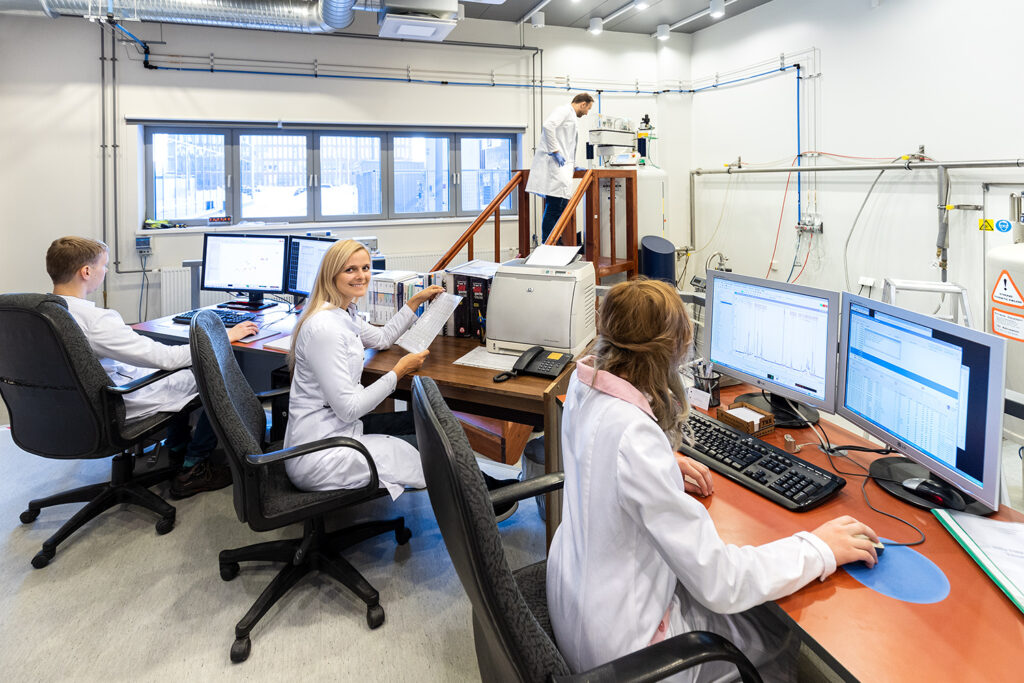The state-of-the-art equipped Wood Chemistry and Bioprocessing Core Laboratory have the capability to test and analyze the lignocellulosic biomass feedstocks (natural fibers, wood and other natural materials), as well the intermediates and products of biomass conversion processes. We have competence in the design and management of bioprocesses, design of production strains, and development in synthetic biology. We are developing novel biomaterials from renewable sources (e.g. high-performance polymer materials from lignin-cellulose precursors). We design our services according to your company’s specific needs to allow the best use of biomass feedstocks and achieve optimal production.
Biomass Analysis
- Chemical composition of biomass and characterization of products
- Dry matter content (moisture content)
- Ash (525 °C or 900 °C ignition)
- Elemental analysis
- Extractives (fatty acids, resin acids, sterols, lignans, steryl esters, triglycerids, terpenes, etc.) – water, acetone, ethanol, THF, etc. soluble extractives
- Characterization of volatile organic compounds in biomass
- Carbohydrates content and composition (sugars in cellulose and hemicellulose – total sugars, glucose, xylose, mannose, arabinose, galactose, rhamnose) – acid hydrolysis method
- Carbohydrates and uronic acids (glucose, xylose, mannose, arabinose, galactose, rhamnose, glucuronic acid, 4-O-methyl-D-glucuronic acid, galacturonic acid, mannuronic acid, and guluronic acid) – enzymatic hydrolysis method
- Starch content
- Lignin content (Klason lignin, acid soluble lignin, acid insoluble lignin, total lignin)
- Proteins and amino acids
- Determination of the structure of organic matter by nuclear magnetic resonance spectrometer (NMR)
- And a large number analyzes of different chemical properties of biomass and products
- Macromolecular properties of biomass components
- Alpha-, beta- and gamma-cellulose
- Functional groups – acidic, hydroxyl (aliphatic, phenolic, carboxylic), acetyl, methoxy groups, etc. – reactivity
- Analysis of macromolecular properties of lignocellulosic biomass components, cellulose, hemicellulose and lignin molecular mass distribution
- Solubility of lignin
- Physical properties of biomass and biobased polymers/materials
- Structural analyses by NMR, FTIR
- Particle size and distribution analyses
- Molecular weight and polydispercity index (size-exclusion chromatography) of biopolymers (Mn, Mw, PDI)
- Thermochemical properties (glass transition temperature (Tg), softening temperature (Ts), etc.)
- Thermogravimetric analysis
- Density
- Viscosity
- Fluid absorption
- Fine structure characterization of natural fibers and biomaterials by atomic force microscopy (AFM), X-ray diffraction (XRD), scanning electron microscope (SEM) methods
- Dynamical mechanical analysis (DMA)
Bioprocessing
- Characterisation of microbial strains in batch, fed-batch, and continuous cultures (e.g. chemostat, turbidostat) under strictly controlled environmental conditions, including gas fermentation, both on sugar and gaseous (from gasification) substrates derived from biomass.
- Fermentation platform enables to culture cells under both both aerobic and strictly anaerobic conditions.
- Bioprocess optimisation and design (e.g. screening for best growth conditions, media and gas feed optimisation, fermentation profiles).
- Adaptive laboratory evolution experiments (improving strin performance for higher stress tolerance and performance).
- Transcriptomics, proteomics (including postranslational modifications) and metabolomics-level characterization of microorganisms.
- Bioinformatics analysis and construction of genome-scale models for any microorganism
- Metabolic design of cell factories using genome-scale models
- Strain modifications and metabolic engineering, including development of synthetic biology toolboxes for non-conventional yeast strains.
Relevant analytical and processing equipment includes:
- Gas Chromatographs (GC) (Flame Ionization, Thermal Conductivity detectors)
- Gas Chromatograph-Mass Spectrometers (GC/MS)
- Ion Chromatographs (IC)
- High Performance Liquid Chromatographs (HPLC) (UV-Vis absorbance, Photodiode Array, Refractive-Index, Conductivity, Fluorescence detectors)
- High Performance Liquid Chromatographs-Mass Spectrometers (HPLC/MS)
- Infrared spectroscopes (FT-IR-ATR)
- Size Exclusion Chromatographs (SEC)
- Particle Size Analyzers (PSA)
- UV/Vis spectroscopes (UV/Vis)
- Mass Spectrometers (MS)
- Polarimeter
- Nuclear Magnetic Resonance spectroscopes (NMR, 200; 400; 700 MHz)
- Thermogravimetric Analyzer (TGA)
- Laboratory Drying Ovens (conventional and with vacuum) for biomass samples
- Lyofilisators
- Laboratory Muffle Stoves
- Scanning Electron Microscopes (SEM)
- Atomic Force Microscope (AFM)
- High Performance Flash and Medium Pressure Liquid Chromatographs
- High pressure reactors
- Ultrasonic reactors
- Microwave reactor
- Extraction equipment (Soxhlet extractors)
- Gas Chromatographs (GC) (Flame Ionization, Thermal Conductivity detectors)
- Gas Chromatograph-Mass Spectrometers (GC/MS)
- Dedicated laboratory for working with explosive and toxic gases, i.e. gas fermentation facility. The lab is equipped with special equipment for working in environments above ambient pressure and for monitoring such processes.
- Multiple 1L bioreactors equipped with on-line sensors for monitoring and controlling ORP, pH, dissolved O2, and temperature enabling the conduct microbial fermentations in batch, fed-batch, and continuous cultures. Experiments on both aerobic and anaerobic conditions
- High-throughput mini-bioreactor system equipped with sensors for controlling temperature and monitoring biomass and dissolved O2
- Mass spectrometer that enables continuous and high-sensitivity analysis of both bioreactor off-gases and manually injected samples (both identifacation and quantification of compounds).
- Anaerobic chamber that enables to conduct various experimental work (e.g. culturing cells, media and sample preparation) under strictly anaerobic conditions (O2<5ppm).
- Laminars, incubators, light microscope and other equipment for sampling for various analyses e.g. metabolomics, proteomics, transcriptomics, fatty acids.
- Infrastructure for genetic engineering of various yeast strains

